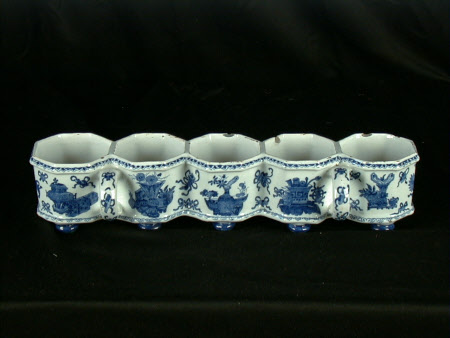Container
Adrianus Kocx (fl.1686 - 1701)
Category
Ceramics
Date
1687 - 1701
Materials
tin-glazed earthenware, in-glaze cobalt blue and manganese black
Measurements
84 x 115 mm; 410 mm (L)
Place of origin
Netherlands
Order this imageCollection
Dyrham, Gloucestershire
NT 452230
Summary
Condiment stand, delftware, formed of five interlinked, straight sided octagonal holders, each on two bun feet, two loop handles to one side, Adriaen Kocx, De Grieksche A, Delft Netherlands, 1687-1701; on glaze decoration with stylised antiques and scholar's objects after Chinese porcelain, including vases and archaic vessels containing flowers, feathers, scrolls, etc., the feet in blue, band of lambrequin at the upper rim, band of double scrolls at foot rim.
Full description
The collection of Dutch delftware at Dyrham is one of the best historical collections of this material in the world, rivalling those at Hampton Court and Chatsworth. Most collections of delftware at this time were assembled by courtiers such as the Duke of Devonshire or the Earl of Portland. William Blathwayt (1649-1717) wasn’t an aristocrat, he was a government administrator – an early civil servant. However, he was a brilliant networker with direct connections to the Palace. He began his career in the Hague as private secretary to the British Ambassador, where he learnt to speak Dutch. Blathwayt served under six monarchs during his long career, including King William III and Queen Mary II, who was herself an avid collector of delftware. Blathwayt’s ceramics reflect his ambition to recreate the fashionable court style of William and Mary in his own home, as well as expressing his loyalty to the crown. The collection of delftware at Dyrham includes rare and unique forms, including some that are likely to have a direct royal connection. Another important aspect is its documentary evidence. Many pieces are listed in inventories of Dyrham made in 1703 and 1710 – around the time the pieces were being acquired by Blathwayt and their early use at Dyrham. About a third of the original collection remains at the property. This object is described in the 1703 inventory as 'a Range of Cupps Delf’ and in 1710 as 'a Range of blew and white Delf cups.' It is made of five interlinked octagonal stands that most probably contained delftware bottles or cruets for spices and condiments. Examples of delftware cruet stands are known, but usually have two or three holders - this is an extremely rare, perhaps unique survival. It was made at the De Grieksche A factory in Delft. This was one of the major producers of delftware and the favoured supplier of Queen Mary.
Provenance
Indigenous collection purchased by Ministry of Works in 1956 and given to Dyrham Park in 1961.
Marks and inscriptions
Underside of base: AK (hand painted, on glaze, blue)
Makers and roles
Adrianus Kocx (fl.1686 - 1701), maker
References
Walton 1986 Karin-M. Walton, An Inventory of 1710 from Dyrham Park, The Furniture History Society, vol. XXII, London 1986, pp.25-80
